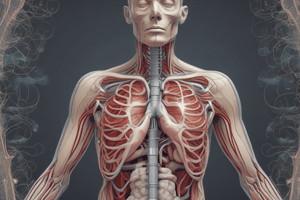Podcast
Questions and Answers
What is the approximate volume of air inspired or expired during a normal inspiration or expiration?
What is the approximate volume of air inspired or expired during a normal inspiration or expiration?
- 700 ml
- 500 ml (correct)
- 1000 ml
- 300 ml
Which pulmonary volume measures the amount of air inspired forcefully after a normal inspiration?
Which pulmonary volume measures the amount of air inspired forcefully after a normal inspiration?
- Expiratory reserve volume
- Residual volume
- Tidal volume
- Inspiratory reserve volume (correct)
Which term describes the volume of air inspired or expired during a normal respiration?
Which term describes the volume of air inspired or expired during a normal respiration?
- Expiratory reserve volume
- Inspiratory reserve volume
- Residual volume
- Tidal volume (correct)
What does the expiratory reserve volume measure?
What does the expiratory reserve volume measure?
What is another name for the normal airflow volume during regular breathing?
What is another name for the normal airflow volume during regular breathing?
Which structures are part of the upper respiratory tract?
Which structures are part of the upper respiratory tract?
What type of epithelium lines the alveoli?
What type of epithelium lines the alveoli?
Which part is NOT included in the lower respiratory tract?
Which part is NOT included in the lower respiratory tract?
Which structures are lined with ciliated columnar epithelium?
Which structures are lined with ciliated columnar epithelium?
The larynx is a part of which division of the respiratory system?
The larynx is a part of which division of the respiratory system?
Which function of the nose helps to remove particles and pathogens from the air?
Which function of the nose helps to remove particles and pathogens from the air?
What role does the nose play in the process of speaking?
What role does the nose play in the process of speaking?
How does the nose contribute to maintaining proper moisture levels in inhaled air?
How does the nose contribute to maintaining proper moisture levels in inhaled air?
Which function of the nose is involved in the perception of scents?
Which function of the nose is involved in the perception of scents?
Which function of the nose helps to prevent the drying of lung tissue?
Which function of the nose helps to prevent the drying of lung tissue?
What function does the pharyngeal tonsils' lymphatic tissue serve?
What function does the pharyngeal tonsils' lymphatic tissue serve?
Which of the following is a function of the pharynx related to air?
Which of the following is a function of the pharynx related to air?
Which function of the pharynx aids in the process of speech?
Which function of the pharynx aids in the process of speech?
What role does the pharynx play in the digestive system?
What role does the pharynx play in the digestive system?
Which of the following is a sensory function of the pharynx?
Which of the following is a sensory function of the pharynx?
Flashcards are hidden until you start studying
Study Notes
Pulmonary Volumes
- Tidal Volume • Approximately 500 ml of air is inspired or expired during a normal inspiration or expiration
- Inspiratory Reserve Volume • The amount of air that can be forcefully inspired after the normal tidal volume has been inspired
- Expiratory Reserve Volume • The amount of air that can be forcefully expired after the normal tidal volume has been expired
Respiratory System Divisions
- The respiratory system is divided into two main parts: the upper tract and the lower tract
- The upper tract consists of the nose, pharynx, and associated structures
- The lower tract consists of the larynx, trachea, bronchi, and lungs
- The respiratory tracts are lined with ciliated columnar epithelium
- The alveoli, responsible for gas exchange, are lined with single squamous nonciliated epithelium
- The different parts of the respiratory system include the nasal cavity, pharynx, larynx, trachea, bronchi, and lungs
Pulmonary Volumes
- Tidal volume: approximately 500 ml of air inspired or expired during a normal inspiration or expiration
- Inspiratory reserve volume: additional air inspired forcefully after normal tidal volume inspiration
- Expiratory reserve volume: additional air expired forcefully after normal tidal volume expiration
Functions of the Nose
- Warms the air
- Cleans and filters the air
- Humidifies the air
- Enables the sense of smell
- Resonates speech
Respiratory System Divisions
- Upper Respiratory Tract
- Consists of nose, pharynx, and associated structures
- Lower Respiratory Tract
- Includes larynx, trachea, bronchi, and lungs
- Respiratory tracts lined with ciliated columnar epithelium
- Alveoli lined with single squamous non-ciliated epithelium
Functions of Pharynx (Throat)
- The pharynx acts as a passage for both air and food, facilitating their movement through the respiratory and digestive systems.
- The pharynx plays a crucial role in warming and humidifying inhaled air, preparing it for the lungs.
- The pharynx is involved in the sense of taste, as it houses taste buds that detect flavors in food and drinks.
- The pharynx contains lymphatic tissue in the form of pharyngeal tonsils, which produce antibodies to combat microorganisms and protect the body from infections.
- The pharynx plays a significant role in speech production, as it helps to modulate sound and articulate words.
Studying That Suits You
Use AI to generate personalized quizzes and flashcards to suit your learning preferences.




